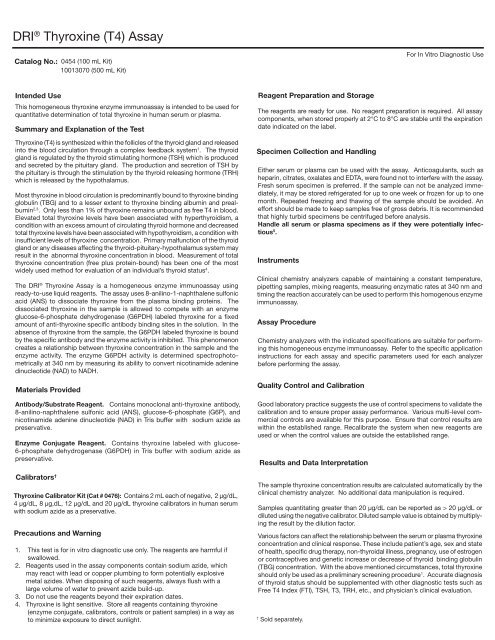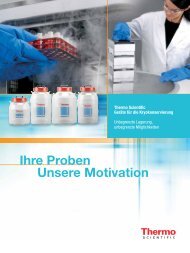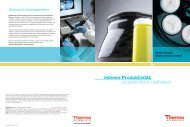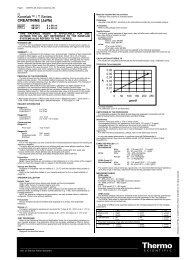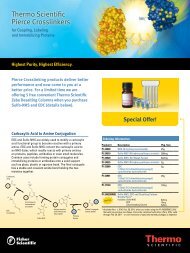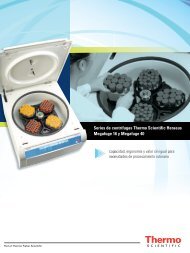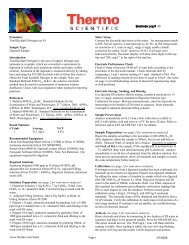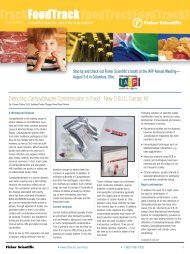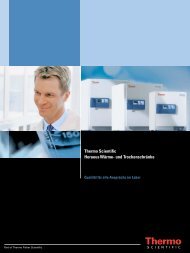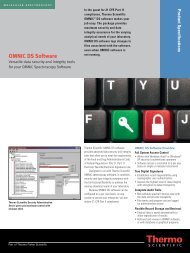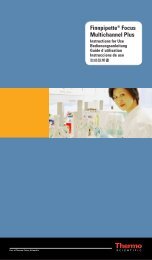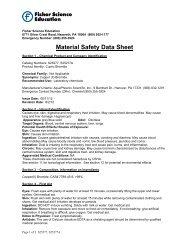DRI® Thyroxine (T4) Assay
DRI® Thyroxine (T4) Assay
DRI® Thyroxine (T4) Assay
Create successful ePaper yourself
Turn your PDF publications into a flip-book with our unique Google optimized e-Paper software.
DRI ® <strong>Thyroxine</strong> (<strong>T4</strong>) <strong>Assay</strong><br />
Catalog No.: 0454 (100 mL Kit)<br />
10013070 (500 mL Kit)<br />
Intended Use<br />
This homogeneous thyroxine enzyme immunoassay is intended to be used for<br />
quantitative determination of total thyroxine in human serum or plasma.<br />
Summary and Explanation of the Test<br />
<strong>Thyroxine</strong> (<strong>T4</strong>) is synthesized within the follicles of the thyroid gland and released<br />
into the blood circulation through a complex feedback system 1 . The thyroid<br />
gland is regulated by the thyroid stimulating hormone (TSH) which is produced<br />
and secreted by the pituitary gland. The production and secretion of TSH by<br />
the pituitary is through the stimulation by the thyroid releasing hormone (TRH)<br />
which is released by the hypothalamus.<br />
Most thyroxine in blood circulation is predominantly bound to thyroxine binding<br />
globulin (TBG) and to a lesser extent to thyroxine binding albumin and prealbumin<br />
2,3 . Only less than 1% of thyroxine remains unbound as free <strong>T4</strong> in blood.<br />
Elevated total thyroxine levels have been associated with hyperthyroidism, a<br />
condition with an excess amount of circulating thyroid hormone and decreased<br />
total thyroxine levels have been associated with hypothyroidism, a condition with<br />
insufficient levels of thyroxine concentration. Primary malfunction of the thyroid<br />
gland or any diseases affecting the thyroid-pituitary-hypothalamus system may<br />
result in the abnormal thyroxine concentration in blood. Measurement of total<br />
thyroxine concentration (free plus protein-bound) has been one of the most<br />
widely used method for evaluation of an individual’s thyroid status 4 .<br />
The DRI ® <strong>Thyroxine</strong> <strong>Assay</strong> is a homogeneous enzyme immunoassay using<br />
ready-to-use liquid reagents. The assay uses 8-anilino-1-naphthalene sulfonic<br />
acid (ANS) to dissociate thyroxine from the plasma binding proteins. The<br />
dissociated thyroxine in the sample is allowed to compete with an enzyme<br />
glucose-6-phosphate dehydrogenase (G6PDH) labeled thyroxine for a fixed<br />
amount of anti-thyroxine specific antibody binding sites in the solution. In the<br />
absence of thyroxine from the sample, the G6PDH labeled thyroxine is bound<br />
by the specific antibody and the enzyme activity is inhibited. This phenomenon<br />
creates a relationship between thyroxine concentration in the sample and the<br />
enzyme activity. The enzyme G6PDH activity is determined spectrophotometrically<br />
at 340 nm by measuring its ability to convert nicotinamide adenine<br />
dinucleotide (NAD) to NADH.<br />
Materials Provided<br />
Antibody/Substrate Reagent. Contains monoclonal anti-thyroxine antibody,<br />
8-anilino-naphthalene sulfonic acid (ANS), glucose-6-phosphate (G6P), and<br />
nicotinamide adenine dinucleotide (NAD) in Tris buffer with sodium azide as<br />
preservative.<br />
Enzyme Conjugate Reagent. Contains thyroxine labeled with glucose-<br />
6-phosphate dehydrogenase (G6PDH) in Tris buffer with sodium azide as<br />
preservative.<br />
Calibrators †<br />
<strong>Thyroxine</strong> Calibrator Kit (Cat # 0476): Contains 2 mL each of negative, 2 µg/dL,<br />
4 µg/dL, 8 µg,dL, 12 µg/dL and 20 µg/dL thyroxine calibrators in human serum<br />
with sodium azide as a preservative.<br />
Precautions and Warning<br />
1. This test is for in vitro diagnostic use only. The reagents are harmful if<br />
swallowed.<br />
2. Reagents used in the assay components contain sodium azide, which<br />
may react with lead or copper plumbing to form potentially explosive<br />
metal azides. When disposing of such reagents, always flush with a<br />
large volume of water to prevent azide build-up.<br />
3. Do not use the reagents beyond their expiration dates.<br />
4. <strong>Thyroxine</strong> is light sensitive. Store all reagents containing thyroxine<br />
(enzyme conjugate, calibrators, controls or patient samples) in a way as<br />
to minimize exposure to direct sunlight.<br />
Reagent Preparation and Storage<br />
The reagents are ready for use. No reagent preparation is required. All assay<br />
components, when stored properly at 2°C to 8°C are stable until the expiration<br />
date indicated on the label.<br />
Specimen Collection and Handling<br />
Instruments<br />
Clinical chemistry analyzers capable of maintaining a constant temperature,<br />
pipetting samples, mixing reagents, measuring enzymatic rates at 340 nm and<br />
timing the reaction accurately can be used to perform this homogenous enzyme<br />
immunoassay.<br />
<strong>Assay</strong> Procedure<br />
Chemistry analyzers with the indicated specifications are suitable for performing<br />
this homogeneous enzyme immunoassay. Refer to the specific application<br />
instructions for each assay and specific parameters used for each analyzer<br />
before performing the assay.<br />
Quality Control and Calibration<br />
For In Vitro Diagnostic Use<br />
Either serum or plasma can be used with the assay. Anticoagulants, such as<br />
heparin, citrates, oxalates and EDTA, were found not to interfere with the assay.<br />
Fresh serum specimen is preferred. If the sample can not be analyzed immediately,<br />
it may be stored refrigerated for up to one week or frozen for up to one<br />
month. Repeated freezing and thawing of the sample should be avoided. An<br />
effort should be made to keep samples free of gross debris. It is recommended<br />
that highly turbid specimens be centrifuged before analysis.<br />
Handle all serum or plasma specimens as if they were potentially infectious<br />
5 .<br />
Good laboratory practice suggests the use of control specimens to validate the<br />
calibration and to ensure proper assay performance. Various multi-level commercial<br />
controls are available for this purpose. Ensure that control results are<br />
within the established range. Recalibrate the system when new reagents are<br />
used or when the control values are outside the established range.<br />
Results and Data Interpretation<br />
The sample thyroxine concentration results are calculated automatically by the<br />
clinical chemistry analyzer. No additional data manipulation is required.<br />
Samples quantitating greater than 20 µg/dL can be reported as > 20 µg/dL or<br />
diluted using the negative calibrator. Diluted sample value is obtained by multiplying<br />
the result by the dilution factor.<br />
Various factors can affect the relationship between the serum or plasma thyroxine<br />
concentration and clinical response. These include patient’s age, sex and state<br />
of health, specific drug therapy, non-thyroidal illness, pregnancy, use of estrogen<br />
or contraceptives and genetic increase or decrease of thyroid binding globulin<br />
(TBG) concentration. With the above mentioned circumstances, total thyroxine<br />
should only be used as a preliminary screening procedure 1 . Accurate diagnosis<br />
of thyroid status should be supplemented with other diagnostic tests such as<br />
Free <strong>T4</strong> Index (FTI), TSH, T3, TRH, etc., and physician’s clinical evaluation.<br />
† Sold separately.
Expected Values<br />
The range of <strong>T4</strong> concentrations of apparently healthy individuals has been determined<br />
to be 4.5 to 12 µg/dL. Since the “normal” ranges can be affected by<br />
age, gender, diet, geographic location and other factors, each laboratory should<br />
establish its own expected values for this procedure.<br />
Limitations<br />
This assay is optimized for the determination of thyroxine in serum or plasma<br />
only and not for whole blood thyroxine determination. In rare situations, patients<br />
may have autoantibody that will interfere with the assay and result in low test<br />
results.<br />
Typical Performance Characteristics<br />
The following typical performance data were generated on the Hitachi 717<br />
clinical chemistry analyzer:<br />
Precision<br />
The within-run and total run precision were evaluated with three levels of <strong>T4</strong><br />
serum controls. Following a modified CLSI precision protocol, samples were<br />
tested in replicates of 6 per run, twice a day for 5 days, with total N = 60.<br />
Level Within-run Total-run<br />
n=60 Mean (µg/dL) SD (µg/dL) CV% SD (µg/dL) CV%<br />
1<br />
2<br />
3<br />
Sensitivity<br />
Sensitivity, defined as the lowest concentration that can be differentiated from<br />
the negative serum with 95% confidence, is 0.7 µg/dL.<br />
Accuracy<br />
Specificity<br />
4.1<br />
11.0<br />
16.2<br />
0.14<br />
0.41<br />
0.62<br />
3.4<br />
3.7<br />
3.8<br />
0.28<br />
0.81<br />
1.05<br />
108 clinical samples with <strong>T4</strong> concentration range from 1.3 µg/dL to 87.1 µg/dL<br />
were assayed with DRI ® <strong>Thyroxine</strong> EIA assay and a commercially available <strong>T4</strong><br />
assay. A correlation with a regression equation of DRI (y) = 1.02 (x) - 0.63 and a<br />
correlation coefficient (r) of 0.993 was obtained.<br />
Compounds with chemical structure similar to that of thyroxine and certain concurrently<br />
used compounds were tested for possible cross reactivity in the thyroxine<br />
assay. The % cross reactivity was determined as the percent of equivalent <strong>T4</strong><br />
concentration observed when the tested concentration of the cross reactant was<br />
added to a <strong>T4</strong> negative serum.<br />
Compound Conc. Tested (µg/dL) % Cross Reactivity<br />
Triiodothyronine (T3) 10 3.2*<br />
Triiodothyroacetic Acid 10 0.5*<br />
Tetraiodothyroacetic Acid 10 25.3*<br />
3,5-Diiodothyronine 10,000 0.0<br />
3,5-Diiodotyrosine 10,000 0.0<br />
Iodotyrosine 10,000 0.0<br />
Methimazole 10,000 0.0<br />
Phenylbutazone 10,000 0.0<br />
Phenytoin 10,000 0.0<br />
Propylthiouracil 10,000 0.0<br />
Tyrosine 10,000 0.0<br />
Acetaminophen 100,000 0.0<br />
Acetylsalicylic Acid 100,000 0.0<br />
6.9<br />
7.4<br />
6.5<br />
* The tested concentrations greatly exceed the normal serum concentrations of<br />
these compounds. Therefore the cross reactivity is not clinically significant.<br />
Hemolyzed (up to 800 mg/dL hemoglobin), lipemic (up to 1000 mg/dL triglycerides<br />
or 400 mg/dL cholesterol) and icteric (up to 30 mg/dL bilirubin) samples<br />
have no clinically significant interference on the assay.<br />
Bibliography<br />
1. Ingbar SH, Woeber KA. The Thyroid Gland. In: Text Book of Endocrinology.<br />
Williams RH. ed. Philadelphia, PA; WB Saunders Company, 95 (1974).<br />
2. Robbins J. “<strong>Thyroxine</strong>-Binding Protein in Serum” In: Laborator<br />
Diagnosis of Endocrine Disease. Saunderman and Saunderman eds.,<br />
St. Louis, MO; Warren H. Green, Inc., 221 (1971).<br />
3. Larsen PR, et al. “Immunoassay of <strong>Thyroxine</strong> in Unextracted Human<br />
Serum”, J. Clin. Endocrinol. Metal., 37, 177 (1973).<br />
4. Penney M, O’Sullivan J. Total or Free <strong>Thyroxine</strong> as a Primary Test of<br />
Thyroid Function. Clin. Chem., 33, 170 (1987).<br />
5. Centers for Disease Control/National Institutes of Health manual<br />
“Biosafety in Microbiological and Biomedical Laboratories”. 1988.<br />
Manufacturer: Microgenics Corporation<br />
Customer and<br />
Technical Support<br />
North America<br />
46360 Fremont Blvd<br />
Fremont, CA 94538, USA<br />
US Toll Free: 1 800-232-3342<br />
Other countries:<br />
Please contact your local Microgenics representative.<br />
0475-3


